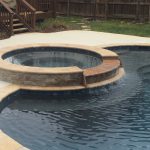Good Pool Maintenance Begins with Knowing Your Pool
Before you can properly enjoy or care for your pool, you might need to brush up on all the parts of your pool. You don’t need to take an annex course or go for your doctorate in swimology from Harvard. But knowing the basic parts of your pool, and their functions, helps you keep everything running smoothly—and makes it easier to resolve issues when they occur.
The Basic Components of a Swimming Pool
Like most major home improvements, you can get as fancy as you like with your swimming pool. You can add advanced heating and lighting, install high-tech pool covers, and even enjoy music while you swim with underwater pool speakers. But whether you have a basic backyard pool or a massive inground oasis shaped like Elvis, every pool has four components that need regular care to keep the good times rollin’.
These include:
- The pool water
- The pool’s interior wall or liner
- The pool’s filter system
- The pool’s system of skimmers and returns
Pool Water
It might seem like a no-brainer but the water in your pool is key to lasting pool happiness. Keeping it clean, clear, and balanced protects you and your family from contaminants and pollutants. It also helps you avoid costly hardware repairs due to corrosion or mineral build-up, and helps your whole pool last longer.
Pool Interior
The walls of your pool liner are in constant contact with pool water, and everything that enters it. Keeping these surfaces in good repair, and clear of algae, mold, and debris, will help keep your pool clean and safe.
Pool Filter System
The pumping heart of your pool is also its liver. OK, that sounds a little weird. But think about it: your pool pump draws water keeps your water circulating, like your heart does with your blood. Your pool filter clears dirt and other contaminants from your water just like your liver filters last night’s cheese fries from your blood.
Both protect you and your pool from harm. Without a functioning filter system, your pool will soon be a cloudy, polluted, and unswimmable mess.
Depending on your setup, you might have a cartridge filter, a sand filter, a diatomaceous earth (D.E.) filter. Or, if you have a salt water system, a salt water chlorinator.
Pool Skimmers and Returns
If your pool’s filter is its liver, then your skimmers and returns are its veins and arteries. Your skimmers—not to be confused with a net skimmer, the cleaning tool attached to a telescoping pole—pull water into the filter for cleaning, while the returns push the cleaned water back into your pool. And like your veins and arteries, they work best when they’re clean and clear of obstructions.
No two pools are alike, and you’ll no doubt encounter pool maintenance challenges specific to your pool as time goes on. But if you’ve got a firm grasp on these four pool components, you’ll be well equipped to face down most upkeep challenges.
The Three C’s of Proper Pool Maintenance
The foundation of effective pool care is built on three simple but important concepts: circulation, cleaning, and chemistry.
Circulation
Even if you never set foot in a Scout meeting as a kid, you probably know that stagnant, still water is (to borrow a term from our own childhoods) grody to the max. In your pool, as in the great outdoors, moving water is cleaner, clearer, and safer. Proper pool circulation is key to healthy and safe swimming.
A pool with good circulation rarely has issues like cloudy water or pool algae infestation. Keep your pump and filter system running daily to maximize circulation.
How long should you run your pool pump? Ideally, 24 hours a day, 7 days a week. But since that’s not feasible for everyone’s budget or equipment, we recommend running your filter at least 10 to 12 hours a day. That’ll turn the water over a few times and help keep your pool safe and clean.
The other key component to good pool circulation is frequently backwashing your filter. Forget notions of “floaties” in your drink. In this case, backwashing refers to reversing the flow of water through your filter and shunting the dirty water and built-up contaminants to the waste port, carrying them out of your pool. If you’re not sure how to clean a pool filter, it’s imperative to learn and make it part of your regular pool care routine.
The method you use to clean and backwash your filter depends on the type of filter you have, but the underlying concepts are largely the same.
Tip: If your pool has a sand filter, add a cup of D.E. powder to boost its filtering power. Cloudy water will clear more quickly as the D.E. aids your sand filter in straining fine particles.
Cleaning
If it has proper circulation, you’ve already made cleaning your pool much easier. But you’ll still need to apply some good old-fashioned elbow grease. The basic tools you’ll need are:
Both Mother Nature and the folks using your pool bring all sorts of wild and wacky things into your pool, from leaves, mold, and the odd duck or frog to residues from shampoos, perfumes, and hair products. Add in the risks of bacterial contamination, and cleaning your pool becomes an absolutely essential part of safe swimming.
Skim, brush, and vacuum your pool weekly, at a minimum. This will keep debris out of your water, and your walls sparkling clean. Baking soda paste works particularly well as a basic scouring cleaner that won’t damage delicate tile or a vinyl liner when you brush.





